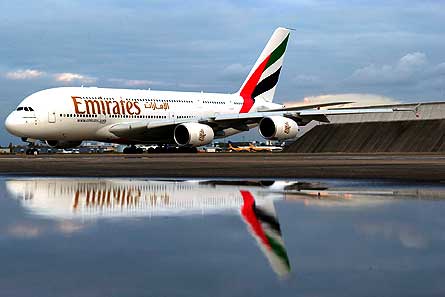Emirates president Tim Clark is optimistic that Airbus’ A380 weight-reduction programme will be successful, but outstanding weight concerns are hampering the airline from committing to the Boeing 747-8.
Dubai-based Emirates is due to take delivery of its first Airbus A380 next August. This will be followed by a further four in 2008 and within two years Emirates will operate 22 of the type.
Speaking at the World Air Transport Forum in Cannes, Clark said: “It is six tonnes overweight, that’s a fact about the A380, but the good thing about it is that Airbus has been working very hard to take weight out of the aircraft.

“We are very pleased to see that there is a definitive weight-reduction programme over the next few years to reduce the manufacturer empty weight by a few tonnes. Of course, that is of great interest to us and I am optimistic that they will get 50% of that weight out, maybe more.”
Clark is eager to take delivery of Emirates’ first A380. He says he is immensely relieved that the first aircraft has been delivered and describes Singapore Airlines’ A380 cabin configuration as “an absolute show-stopper”.
He remains tight-lipped on Emirates’ initial A380 routes, while awaiting definitive dates from Airbus. But he says: “The aircraft that we are taking is the long-range version, so that will be operating on our very long-haul network to New York and Australasia. It may be flying, when we first get it, on some of our European operations.”
Emirates will operate its A380s in three configurations. Its crew rest-equipped long-range versions will house 489 passengers in a three-class configuration, while the non-crew rest version will accommodate 531 passengers. Emirates is also planning to operate some of its A380s in a two-class layout, with 617 passengers.
Clark says Emirates is still interested in the larger A380-900, which he claims would be a simple, but low-demand, stretch. Emirates would configure the aircraft with 531 seats in three classes or around 700 in a two-class layout.
He says: “We are still interested in [the A380-900]. We could do with a few of those now. It is an easy one to do because the wing is there, the propulsion is there. All they need to do is stretch the fuselage and ‘bingo’. I am sure it will come.
“There won’t be many of us who want it, but at that point it doesn’t matter because the manufacturing economics become incremental. They’ll have gone through the 200 or 300 they need to break even and beyond that, to stretch the aircraft, would be a $2-5 billion investment. We’d take it straight away.”
Clark says Emirates would consider the 747-8 if it met the airline’s requirements, but he is again concerned about weight. He says: “It is not there yet either. We are not ready to sign a contract. We’ve got to be sure that they would deliver the aircraft on the table at the moment, which will require some copper-bottomed guarantees.”
Emirates is also working with both Boeing and Airbus to find ways of cutting controllable weight across its in-service fleet, evaluating options such as shifting some of its paper literature into its in-flight entertainment system.
Clark says: “We are looking at multiple ways to take weight out of the aircraft – that’s weight that we control, like catering, galleys, carts, carpets, seat weight, water, magazines. We are working with both Boeing and Airbus to find ways and means of stripping weight out from the aircraft in a very pro-active manner.”
Source: FlightGlobal.com























